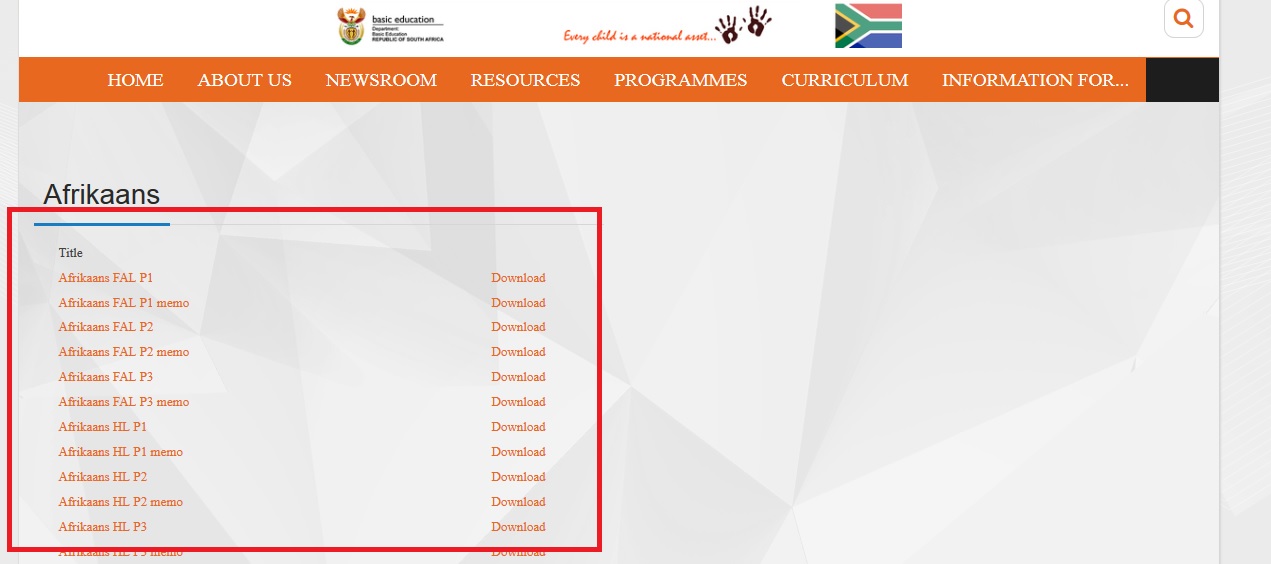education.gov.za Grade 12 NSC November Past Papers 2018 : Department of Basic Education
Organisation : Department of Basic Education
Exam Name : National Senior Certificate Examinations (Grade 12)
Question Paper : NSC November Past Papers 2018
Website : https://www.education.gov.za/2018NSCNovemberpastpapers.aspx
| Want to comment on this post? Go to bottom of this page. |
|---|
How To Download NSC Grade 12 Past Papers?
NSC November 2018 Past Papers are available in the official website of Department of Basic Education.
Related / Similar Question Paper : NSC Grade 12 November Past Papers 2019

Just follow the simple steps mentioned below to download the NSC November Past Papers 2018.
Steps:
Step-1 : Go to the the official website of Department of Basic Education (i.e.https://www.education.gov.za/)

Step-2 : Click on “Past Exam papers (Grade 12)” link under ”Quick Links” available on the Home Page.

Step-3 : Then Click on “2018 November NSC Examination Papers” link under “Past Exam papers (Grade 12)”.

Step-4 : Past Papers page will open. Click on the Subjects link to download the question papers.

NSC Grade 12 English Question Paper
Question-1: Read Text A and answer the set questions.
Text A : Sole-Searching
** Sneakers are casual shoes also known as ‘takkies’. Today, these shoes are a popular choice of footwear worn by all types of people throughout the world.
** The first sneaker was introduced in the 1860s in the form of a specialised running shoe made of leather and spikes. By 1892 the United States Rubber Company modified the design to include a rubber sole. These shoes were mass-produced and nicknamed ‘sneakers’, because of their soft, noiseless rubber soles.
** Today, the sneaker culture is worth billions of rands worldwide. The market continues to grow rapidly. A 2017 report released by Transparency Market Research expects the global footwear market to reach over 3 trillion rands in value by 2020. It is impossible to deny that what was once street culture has turned into a mass consumer movement.
** The market is driven by people known as sneakerheads, who collect, trade or admire sneakers as a hobby. It is also promoted by hip-hop culture and ordinary people who love this type of footwear. The sneaker culture has risen from humble, functional beginnings to the fashion trend it is today.
** Converse, a sneaker manufacturer, was the first company to get celebrities to endorse their products. They set a marketing standard in the world of athletic footwear by adding the name of celebrity basketball player, Chuck Taylor, to the ankle patch of their All Star sneakers.
** What began as a subculture is now universal and the sneaker industry’s growth can be plotted alongside the rise of a music culture from the 1950s, when famous musicians wore this type of footwear. It exploded with the commercialisation of hip-hop. A turning point was the release of rapper RUN-DMC’s track, My Adidas. This signified the beginning of sneaker endorsement¹ deals for non-athletes and what rappers wore started to become popular among the youth.
** ‘From a young age it has always been about having the coolest sneaker but now it is also about the culture,’ explained Thabo and Thabiso Modiselle, founders of culture and sneaker site, YoMzansi. ‘We were influenced by streetwear, music and hip-hop movies, and started studying the culture and educating ourselves on major sneaker brands.’
** Sneaker culture continues to be influenced by basketball and hip-hop music with no signs of slowing down. Teenagers look up to a lot of musicians who can be seen on television wearing these brands. Most teenagers wear what they see on television. They will buy a pair of sneakers because they saw one of their favourite artists post it on social media, or wearing them in a new music video.
** As streetwear devotee, Naledi Radebe, puts it, ‘At the most basic level, sneakers are a form of transport. At the highest, they are a symbol of character and status. All these shoes say something about the people who own them. They are a representation of the energy and spirit you, as an individual, want to send to the world.’
** Sneaker brands have changed their business model only a decade ago and now rely on the internet to promote their products. One can always find out about fresh trends on Instagram or use specific websites to order directly. Technology has made it infinitely quicker to share sneaker information and to sell them across the globe.
** The online shopping for sneakers has been made easy. Some people still enjoy the culture of walking into the store and trying on a pair of sneakers. However, others are moving towards online shopping because of the wide range available, regardless of where they are in the world.
** The sneaker culture is serious business. Today sneakers go way beyond fashion or functionality; they signify who you are through the choices you make.
** Sneakers have the unique power to transcend boundaries of gender, age and socio-economic standing, positioning them as the footwear of choice for millions of people.
1.1 Refer to paragraph 2.
1.1.1 Quote TWO consecutive words which indicate that sneakers were first used by athletes.
1.1.2 Using your OWN words, explain why this type of footwear was named sneakers.
1.2 What does the writer mean by, ‘turned into a mass consumer movement’ (line 12)?
1.3 Explain why the following statement is FALSE:
Sneakerheads is a brand of footwear.
1.4 Refer to paragraph 5.
Give TWO reasons why Converse added the name of celebrity basketball player, Chuck Taylor, to their sneakers.
1.5 How did the music industry make sneakers popular (paragraph 6)?
1.6 Choose the correct answer to complete the following sentence:
The word ‘coolest’ (line 28) means …
A calmest.
B trendiest.
C coldest.
D youngest.
1.7 Name TWO types of media used to influence the sale of sneakers (paragraph 8).
1.8 Refer to paragraph 9.
1.8.1 Which word in this paragraph means the same as ‘follower’?
1.8.2 What does Naledi Radebe mean by ‘sneakers are a form of transport’ (line 40)?
1.9 Refer to paragraph 10.
1.9.1 How do you, as the reader, know that the promotion of sneakers on the internet is a fairly recent practice?
1.9.2 Identify a social media app (application) mentioned in this paragraph.
1.10 What are the benefits of buying sneakers online? State TWO points.
1.11 Briefly discuss whether you agree with the writer’s view expressed in paragraph 13.
1.12 Discuss the suitability of the title, ‘Sole-searching’.
FAQ On National Senior Certificate Examination
Here are some frequently asked questions (FAQ) about the National Senior Certificate (NSC) Examination:
Q: What is the National Senior Certificate Examination?
A: The National Senior Certificate Examination (NSC) is a standardized test taken by South African students at the end of their twelfth year of schooling. It is commonly known as the matriculation exam and is a requirement for admission to higher education institutions in South Africa.
Q: When is the NSC Examination held?
A: The NSC Examination is typically held in November of each year, with results released in January of the following year.
Q: What subjects are covered in the NSC Examination?
A: The NSC Examination covers a range of subjects, including languages (such as English, Afrikaans, and other official languages), mathematics, science, and social sciences. Students typically choose to specialize in specific subject areas based on their academic interests and career goals.
Q: How is the NSC Examination graded?
A: The NSC Examination is graded on a scale from 1 to 7, with a score of 4 or higher considered a passing grade. Students receive a separate grade for each subject they take, and their overall performance is reflected in their National Senior Certificate.